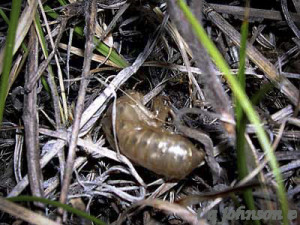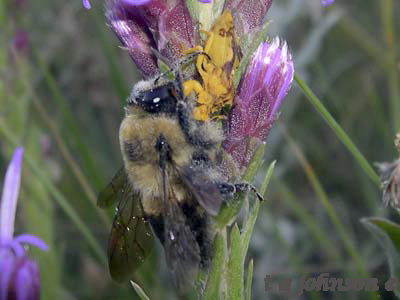Class: Insecta
Order: Hemiptera
Family: Cicadidae
So, who hits those real high ear-piercing notes that’s a true bug performer/ rock and roll star? Definitely the Cicada’s rhythmically magical riffs ringing in the day’s hot times. Always a local favorite musical performer here as the boys of Dog-Days Summer. When Large groups of males congregate together to call a Female Mate it’s called, “Chorusing Centers.” The males can sing almost as loud as a concert here at the Red Rocks Amphitheater; well, almost- like between 80 and 100 decibels, where a rock concert can easily exceed 120 decibels.
Cicadas are a family of insects in the Order Hemiptera. Within the last few years, the order Hemiptera was considered two separate orders Hemiptera and Homoptera. Hemipterans are considered the “true bugs”, those with sucking mouthparts. Homopterous also have sucking mouthparts and show enough similarities with Hemiptera to be considered the same order. All insects in the former order of Homoptera feed on plants.
Species of Cicadas are considered either dog-day cicadas or periodical cicadas. The periodical cicadas are among the longest living insects known and date back to the Jurassic Period. Scientist still don’t know why the timing is so accurate to the 17th yr. and 13 yr. exactly, except that they are all prime numbers.
There are six species of periodical cicadas; three 17 yr. and three 13 yr. types. In North America these insects are among the largest reaching lengths of 5 cm with the smallest about half that in size. Along Bear Creek in Morrison, Colorado and Mt. Vernon Creek next to the Red Rocks appear these Dog-day cicadas every annual Spring and Summer. Accept the life-cycles of the so-called annual cicada are not really Annual. The emergence of the Adult Nymph can take between 2 and 5 yrs. All other cicadas from all other biographic regions produce Annual Broods.
Some Trillion Periodical Cicadas will swarm in this rare 2 Century emergence event in the Spring and Summer of 2024. Any two specific broods of different life cycles dual-emerge only every 221 years; including both these specific broods of the 13 yr. and 17 yr. cycle type. This will occur both in the North East with the Northern Illinois and South East Great Southern Brood.
Cicadas will fly up and crawl out to the tips of branches to lay eggs in the end twigs of trees and shrubs thus damaging that small area beyond the point of no return causing its demise and then falls to the ground. The egg develops for around a month before hatching into a larva. When the damaged twig falls onto the ground the hatching nymph crawls under the ground and buries itself. Underground the larvae will find a root (mostly perennials) and using its sucking mouth parts (proboscis) attach itself to the root.
The sole food of the insect nymph comes from liquids flowing in the “plumbing” of a Tree Root and plants living in improved organic soil and can go a long way in explaining why the developmental time is so long for the 17-year variety. Beside a few trace minerals there is very little nutrition in a Tree Root and other plants including the rhizoid on root hairs.
Before the last molt to adulthood, the cicada will climb out of the ground opening little holes too, they crawl up into the natural grasses or other plants for cover to shed its final protective casing. Newly emerged cicadas climb up trees and molt into their adult stage, now equipped with wings. In the summer these holes and casings seen (below) are readily observable. The adults live about a month or so around here until the cycle starts all over again.

While you may not have seen one of these magnificent insects you certainly have heard then. The often-deafening sound that is so high pitched that its ringing becomes a familiar ‘Rock’ tune in the “dog days of summer.” Sometimes leading to crescendos of ear-piercing length seemly inescapable at times when produced by hundreds of cicadas, in the dog-day afternoon, of Tibicen pruinosa, (seen in photos above).
These high-pitched ringing sounds are produced by the males to woe a Mate by what are called tymbals on the underside of the first abdominal segment. These tymbals are composed of rib like bands that contract and snap due to muscle control. A majority of space in the insect (last thoracic segment and first 5 segments of the abdomen) is a large air sac that acts as a resonator for the sound produced from the tymbals. Not all cicadas produce sound this way. A few species perform stridulating or wing-banging to produce sounds.
Class: Insecta
Order: Hemiptera
Family: Phymatidae (ambush bugs)
Hard to follow the Cicadas act…then, which ‘true’ bug has the sexy bad boy reputation with the big guns to back it up?
These predacious bugs were once classified with the family Reduviidae (assassin bugs) but recently given family status. Both assassin and ambush bugs, as their name suggests, are voracious predators feeding on all types of arthropods. Reduviidae in the genus Triatoma are vectors of disease (sleeping sickness) among humans.
The Phymatidae (shown above) feeds mainly on bees, wasps (Hymenoptera), flies (Diptera) and of course a miller moth or two. They are stouter than the assassin bugs with enlarged fore limbs for grasping onto their prey. These brightly colored insects prefer flowers of similar or equal color value, such as this “Blazing Star” (Liatris punctata) to hid in camouflage for an ambush position grasping onto prey as it approaches to feed.



